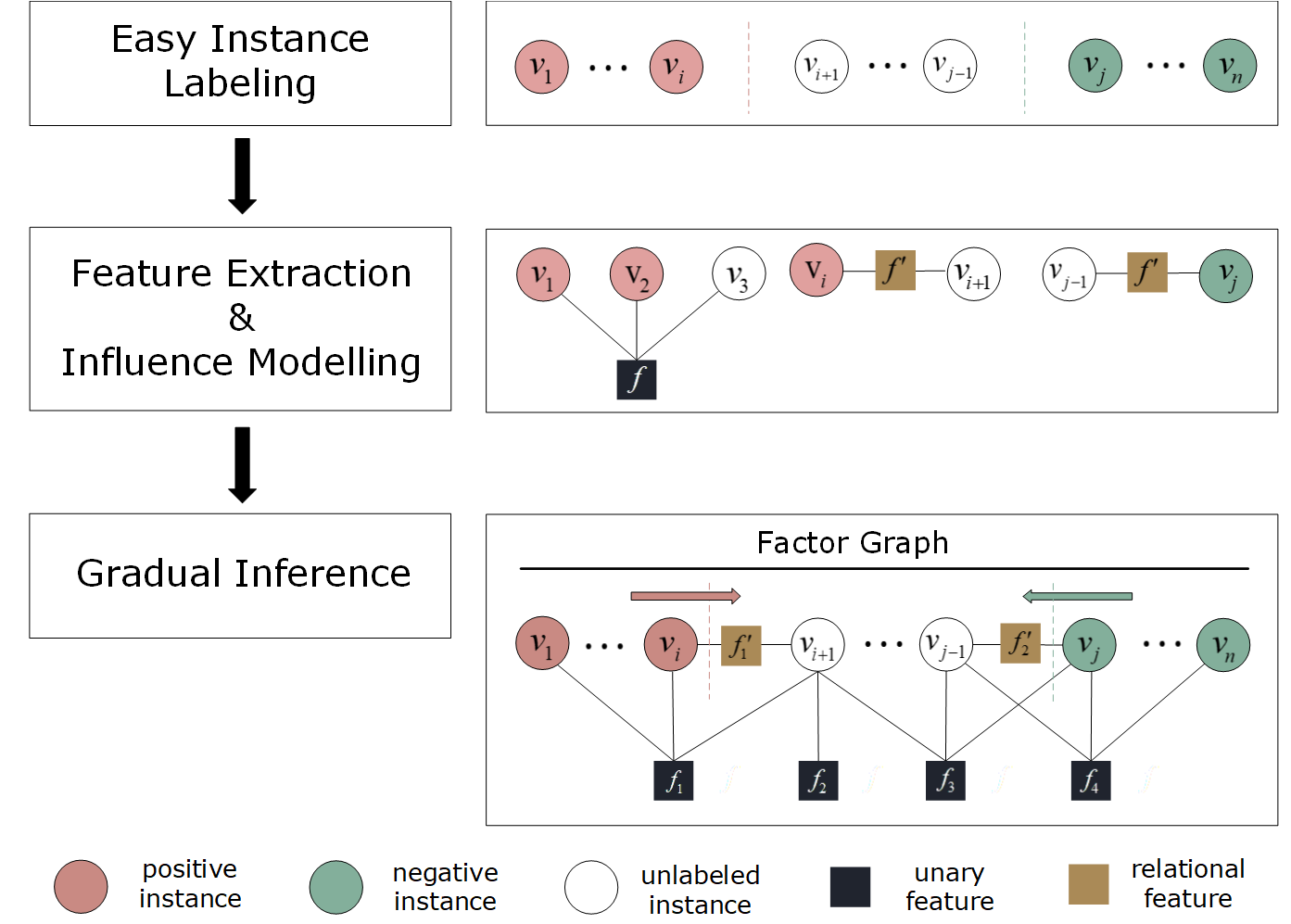Gradual machine learning
Introduction
GML begins with some easy instances in a task, which can be automatically labeled by the machine with high accuracy, and then gradually reasons about the labels of the more challenging instances based on the observations provided by the labeled instances. The following two properties of GML make it fundamentally different from the existing learning paradigms:
- Distribution misalignment between easy and hard instances in a task.
- Gradual learning by small stages in a task.
The scenario of gradual machine learning does not satisfy the i.i.d (independent and identically distributed) assumption underlying most existing machine learning models: the labeled easy instances are not representative of the unlabeled hard instances. The distribution misalignment between the labeled and unlabeled instances renders most existing learning models unfit for gradual machine learning.
Gradual machine learning proceeds in small stages. At each stage, it typically labels only one instance based on the evidential certainty provided by the labeled easier instances. The process of iterative labeling can be performed in an unsupervised manner without requiring any human intervention.
Gradual machine learning is a new and promising research direction supposed to complement deep learning. We have successfully applied gradual machine learning to the classification tasks of entity resolution and sentiment analysis. As a general paradigm, GML can be generalized to various classification tasks. We have also initiated an open-source project, at https://github.com/gml-explore/gml, to support GML application and implementation.
The existing GML solution supposes that features play independent roles in gradual inference. However, in real scenarios, this assumption may be untenable since features are usually correlated with each other. To address this limitation, our new work proposes an attention-enhanced approach to improve the accuracy of gradual inference. The details can be viewed at http://chenbenben.org/agml.html.
Selected Publications
Supervised Gradual Machine Learning for Aspect-Term Sentiment Analysis. Transactions of ACL (TACL), 2023.
Yanyan Wang,Qun Chen,Murtadha H.M.Ahmed,Zhaoqiang Chen,Jing Su,Wei Pan,Zhanhuai Li.
[Abstract]
[PDF]
[Homepage]
DNN-driven Gradual Machine Learning for Aspect-Term Sentiment Analysis. Findings of ACL, 2021.
Murtadha AHMED, QUN CHEN, Yanyan Wang, Youcef Nafa, Zhanhuai Li and Tianyi Duan
[Abstract]
[PDF]
Attention-enhanced Gradual Machine Learning for Entity Resolution. IEEE Intelligent Systems, 2021.
Ping Zhong, Zhanhuai Li, Qun Chen and Boyi Hou
[Abstract]
[PDF]
Aspect-Level Sentiment Analysis based on Gradual Machine Learning.knowledge-based systems(KBS),2020.
Yanyan Wang, Qun Chen, Jiquan Shen, Boyi Hou, Murtadha Ahmed, Zhanhuai Li
[Abstract]
[PDF]
Gradual Machine Learning for Entity Resolution. IEEE Transactions on Knowledge and Data Engineering (TKDE), 2020.
Boyi Hou, Qun Chen, Yanyan Wang, Youcef Nafa, and Zhanhuai Li
[Abstract]
[PDF]
Gradual Machine Learning for Entity Resolution. WWW 2019.
Boyi Hou, Qun Chen, Jiquan Shen, Xin Liu, Ping Zhong, Yanyan Wang, Zhaoqiang Chen,Zhanhuai Li
[Abstract]
[Bibtex]
[PDF]
[Code]
@inproceedings{hou2019gradual,
title={Gradual machine learning for entity resolution},
author={Hou, Boyi and Chen, Qun and Shen, Jiquan and Liu, Xin and Zhong, Ping and Wang, Yanyan and Chen, Zhaoqiang and Li, Zhanhuai},
booktitle={The World Wide Web Conference},
pages={3526--3530},
year={2019},
organization={ACM}
}
Joint Inference for Aspect-Level Sentiment Analysis by Deep Neural Networks and Linguistic Hints. IEEE Transactions on Knowledge and Data Engineering (TKDE), 2019.
Yanyan Wang, Qun Chen, Murtadha Ahmed, Zhanhuai Li, Wei Pan, and Hailong Liu
[Abstract]
[Bibtex]
[PDF]
@article{wang2019joint,
title={Joint Inference for Aspect-level Sentiment Analysis by Deep Neural Networks and Linguistic Hints},
author={Wang, Yanyan and Chen, Qun and Ahmed, Murtadha and Li, Zhanhua and Pan, Wei and Liu, Hailong},
journal={IEEE Transactions on Knowledge and Data Engineering},
year={2019},
publisher={IEEE}
}
Technical Report
Weakly Supervised Gradual Machine Learning for Sentence-Level Sentiment Analysis (Technical Report).
Jing Su, Qun Chen, Yanyan Wang,Wei Pan,Zhanhuai Li.
[Homepage]
Gradual Machine Learning for Entity Resolution (Technical Report).
Boyi Hou, Qun Chen, Yanyan Wang, Youcef Nafa, Zhanhuai Li.
[PDF]
[Source Code]
GML Framework
